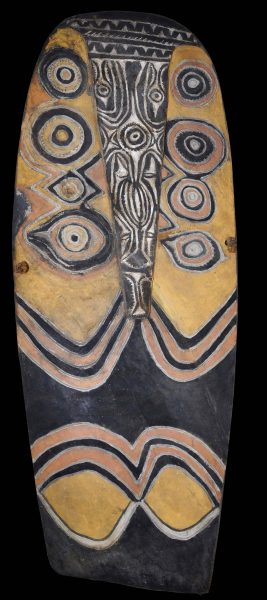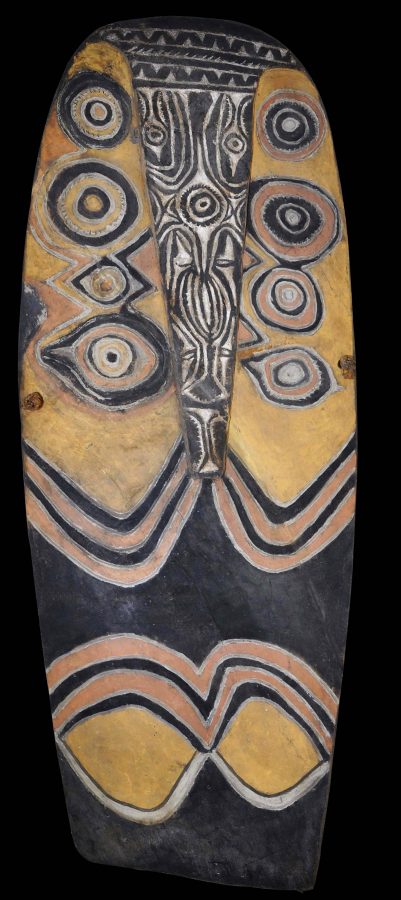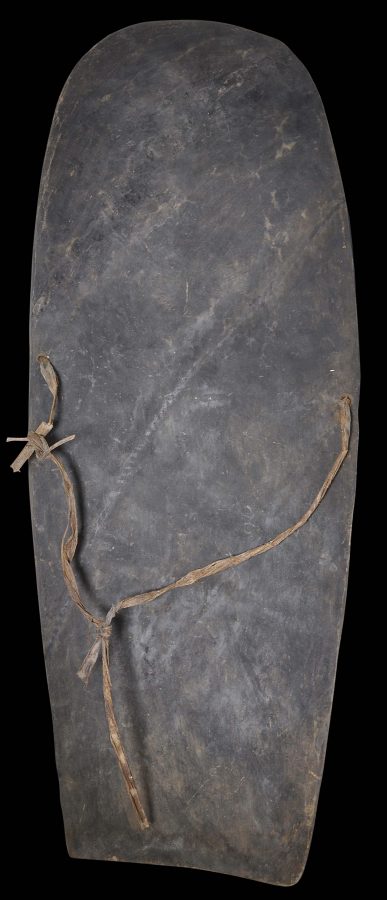Enquiry about object: 2184
Sepik Kominimung Shield
Pora Pora or Bien River, Sepik Region, Papua New Guinea first half of the 20th century
height: 117cm, width: 46cm
Provenance
Francis de Sales McHugh Collection, and thence by descent, collected by de Sales McHugh in the first half of the 20th century.
This unusual wooden ceremonial shield is carved in low relief with a central, raised, triangular section, and coloured with natural ochres. Two holes are drilled to either side through which a coiled or twisted natural fibre rope has been tied to serve as a strap. The triangular section is unique to shields in the Est Sepik Region particularly the Keram and Ramu River areas. But the unusually wide triangular section of the example here with clan symbols to either side suggest it is from the Pora Pora or Bien River Regions located between the Keram and Ramu Rivers (Beran & Craig, 2005, p. 104.)
The outfacing side has been carved and engraved with circular patterns most likely representing totemic animals such as flying foxes and birds, or other clan symbols. The central triangle section is carved with motifs that might signify a lizard. Another interpretation is that it represents the bwongogo, ancestral spirits responsible for the success of activities such as gardening, hunting, fishing, and warfare.
According to observations cited in Peltier & Morin (2007, p. 445), it took approximately 55 hours to make a Kominimung shield over a period of two weeks and involving twenty separate phases. The basic material was obtained from a buttress tree root. A board would be chopped from this.
Shields were used for warfare but also for ceremonial and dance purposes. They were displayed on the side walls of men’s cult houses.
The item was collected in the first half of the twentieth century by Francis de Sales McHugh, who was born in Queensland, Australia in 1896, and who worked in New Guinea as a foreman of works for the Queensland Department of Posts and Telegraphs building regional post offices. It was during this time that he collected this item. It passed to his daughter who now lives in the UK, and in whose possession it had remained since.
The shield appears to have been made from two pieces of wood that have been joined width-ways. The presence of the original carrying strap is important and helps to suggest the shield’s efficacy. As Beran & Craig (2005, p. 104) observe, shields without any obvious form of being carried must have been intended for the tourist market. In any event, the provenance, form and patina of this shield provide testimony to its legitimacy.
See Conru (2005) for a similar example with similar patterns and colouration.
References
Beran, H. & B. Craig, Shields of Melanesia, University of Hawaii Press, 2005.
Conru, K., Southeast African and Oceanic Art, Conru, 2005.
Peltier, P. & F. Morin, Shadows of New Guinea: Art from the Great Island of Oceania in the Barbier-Mueller Collections, Somogy, 2007.




